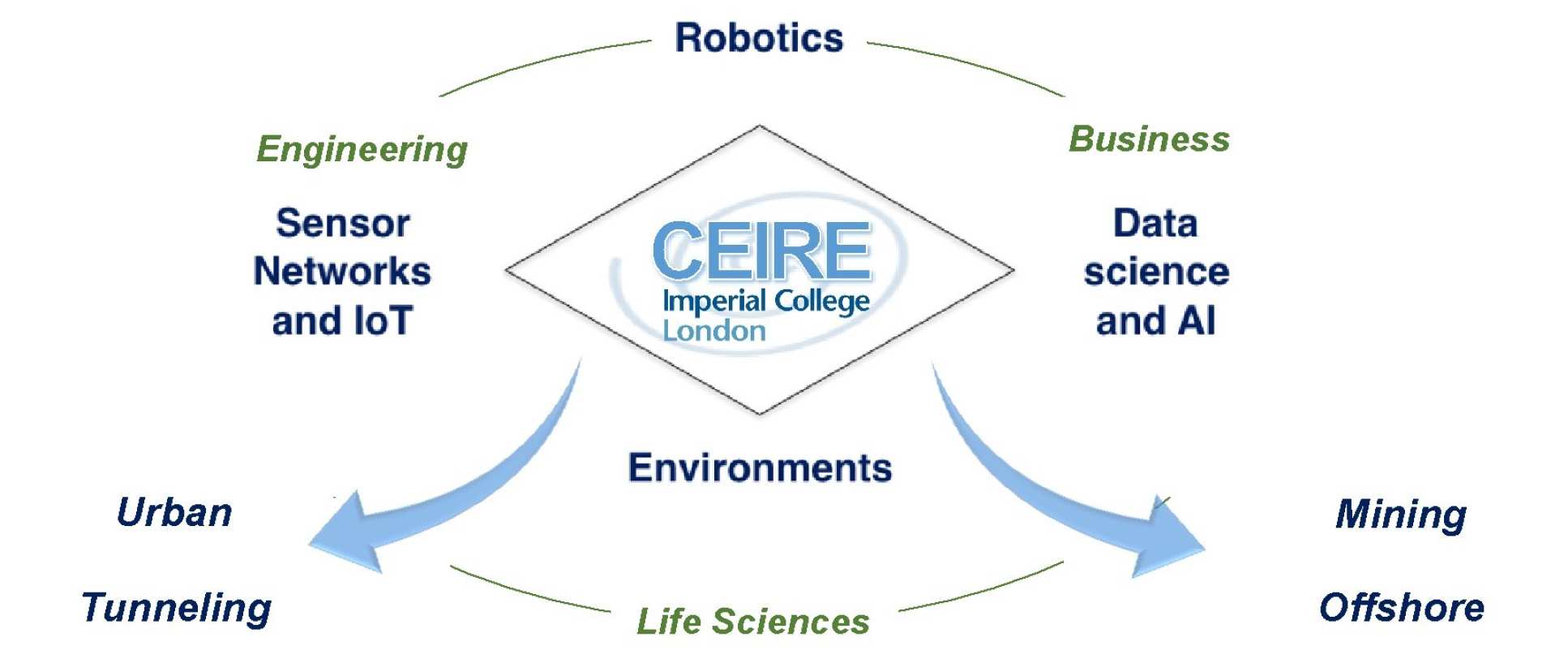 The Imperial Centre of Excellence on Infrastructure Robotics Ecosystems (CEIRE) aims to galvanise academic staff and boost the impact of Imperial initiatives under the theme of Robotics and AI technologies for Infrastructures for cities, underground environments (tunnels, mines, caves) and offshore energy assets.
The Imperial Centre of Excellence on Infrastructure Robotics Ecosystems (CEIRE) aims to galvanise academic staff and boost the impact of Imperial initiatives under the theme of Robotics and AI technologies for Infrastructures for cities, underground environments (tunnels, mines, caves) and offshore energy assets.
CEIRE will combine expertise at the interface of robotics, sensor networks, AI, data science, technology business and environmental policy to advance and promote the next-generation of robots to be integrated in the asset management value chain in order to reduce operational costs, environmental impact, and improve safety of workers.
The Centre's work is split into four pillars of research:
Research pillars
Robotics science and engineering
Working on novel robots with soft, compliant structures and multi-sensor navigation frameworks for sensing, perching, mapping, and repair of infrastructures, needed to create a safer working environment.
Sensor networks and orchestration systems
Creating novel sensor network systems to coordinate and orchestrate the robots, infrastructures and operational workflows, including the overall asset management framework, other autonomous servicing equipment and human workers.
Research pillars
Data Science, AI and technology business proposition
Creating a combined machine learning and business model to evaluate the commercial value of robotics technologies for infrastructure industry.
Life Science, environment and policy
Designing and developing technologies for an efficient and sustainable development of the infrastructure sector, including aspects of environmental impact, safety and security.
Future cities
The benefits of using robotic technologies can be significant. For industry, maintenance costs for infrastructure can be reduced by 20% to 40%, increasing asset utilization by up to 20% and reducing capital expenses by between 5% and 10%, all of which improve environmental health and work safety. Infrastructure companies are therefore investing significantly in robotics for innovation and digitalization.
In the long-term, industry is moving toward completely autonomous operation for the inspection and maintenance of infrastructure assets. Future cities and industry 4.0 sites will evolve into complex ecosystems where autonomous and semiautonomous robots will coexist with people, co-operating in symbiosis with the environment and with smart infrastructure systems.
Human-robot ecosystem
To create this human-robot ecosystem, robots will need to respond more flexibly, robustly and efficiently than they do today. For example, future flying robots will need to be designed with the ability to fly safely close to humans and in contact with infrastructure to perform sensing and intervention tasks. Their behaviours will need to be carefully orchestrated to integrate smoothly into our environment and in industry 4.0 workflows.
Taking up this vision, CEIRE will consolidate and extend the link between the Imperial engineering community and the Data Science Institute, the Business School and the Grantham Institute to propose novel technologies and methodologies for an integrated, sustainable, infrastructure management.
Contact
For more information about the Centre and its activities, please contact:
Prof. Mirko Kovac
Centre Director
+44 (0)20 7594 5063
m.kovac@imperial.ac.uk